Now that Thanksgiving has come and gone, the Christmas shopping season is in full swing. Here at UncommonGoods, we like to celebrate the act of giving, but let’s face it – it’s also fun to receive. So I thought it would be fun to mine through some of the data we’ve collected from holidays past and see if any patterns emerge that indicate who gives the best gifts. That way, I’ll know who to be *extra* nice to when next Christmas rolls around…
Below are 7 interesting trends in Christmas gift giving.
(Note: Because we’re a privately held company, I’m not at liberty to divulge just how much data was involved in doing this analysis, but let’s just say it’s, like, a lot. There are also some cases below where I realize seeing the actual dollar figures would be nice, but again – it’s not something I’m really allowed to share. Sorry.)
1. Men procrastinate.
This first observation might seem fairly obvious to some people, but I think it’s interesting nonetheless to see it played out in the data. Women plan ahead; men procrastinate. Women consistently get their holiday shopping done earlier in the season – it’s not until about December 6th that men start to get their act together and their buying rate starts to surpass that of women. So if you want a well thought out gift, you’re more likely to get it from a woman than a man.
(Since we’re an internet retailer, we necessarily have shipping cutoffs somewhere between Dec. 21-23 – otherwise, I’d expect there’d be a big blue spike around 11pm on Christmas Eve.)
But even worse than men in terms of planning ahead are college kids. Splitting the data by age group, we can see that the older you are, the earlier in the season you get your shopping done.
Breaking it down, it looks like the 65+ age group has 60% of their shopping done by Dec. 4. It’s not until Dec. 10 that the 18-20 set get 60% of their shopping done – almost a full week behind their grandparents. I guess experience teaches you not to wait until the last second. Again, it may seem obvious, but if you’re expecting a gift chosen with a lot of forethought, it’s less likely to come from a teenager.
2. 1999 called… and it’s got a great gift for you.
People who are still on AOL are often mocked. But maybe they shouldn’t be. They do, after all, give us the best gifts.
We found that the average dollars spent on gifts was pretty flat across email providers, with the notable exception of AOL. AOL users spent on average 12.2% more than users of other email services.
So while a recent study by Hunch.com found that Gmail users are more attractive, better educated, and better dressers than AOL users, they are also apparently more likely to be cheapskates.
3. Real Americans live in California.
For a number of reasons – economic, social, environmental – we try our best at UncommonGoods to carry products that are made in the USA. We’re not perfect at it – sometimes a product that is really cool or innovative is only available from overseas manufacturers – but when we can, we try to support local artisans and producers. So who does this really appeal to?
I thought we’d find that America’s heartland – the Midwest, where “real” Americans live – would be buying our American-made items at a much faster clip. And I thought we’d find that those treehugging, Che-loving anarchists out on the West Coast could care less about the issue.
Not so. In fact, looking by region at the percentage of all orders that contain items made in the USA, we see the exact opposite.
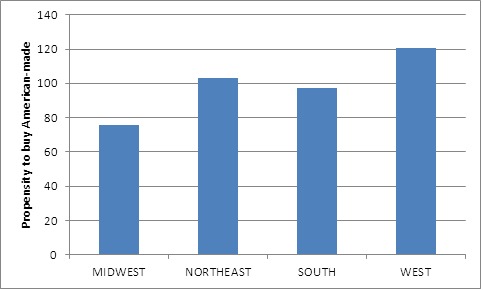
It’s one of the most striking statistics that I came across in doing this analysis. At least amongst our customer base, people on the West Coast are 21% more likely than average to buy American-made, whereas in the Midwest people are 24% less likely than average to do so. That’s a huge difference.
So if you want something that supports artists and designers that reside right here in the good old U-S-of-A, expect it from a Californian.
4. Men have no imagination.
I hate to pile on men here (being a man myself, after all), but apparently men are a lot more likely to run out of good ideas and just buy someone a gift certificate.
In our data, men are 23% more likely to give a gift certificate than women are. I guess a more positive way of putting this is that men are more utilitarian, and more likely to give you the gift of options, guaranteeing that you’ll like what you get.
Still seems kind of lame to me. If you want a more personally meaningful gift, you’re more likely to get it from a woman.
5. The older you get, the more you care about other people.
OK, so we have this program at UncommonGoods called Better to Give, where we give $1 from each order to one of four non-profits that customers can choose from at checkout. It’s a cool program – it really reflects what UncommonGoods is all about and it’s one of the reasons I was really excited to work here in the first place.
The thing is, many of our customers don’t actually pick a non-profit to have us donate to. That’s always puzzled me – I mean, there is really no catch and no cost to customer, other than the maybe 15 seconds it takes to read the description of the program and make a selection. But still, a lot of people don’t do it.
What’s interesting though is that the level of participation in Better to Give goes up with age. It’s not because older people have more money – again, these donations come out of our pockets, not our customers’. It just seems like older people have more patience to read through a little text. Maybe they have longer attention spans.
It’s also interesting to look at the geographic breakdown of Better to Give participation. Amongst states, Vermont leads in participation, with customers there being 32% more likely than average to select a non-profit. Given the Vermonters that I know personally, that’s hardly a surprise – they all seem like do-gooder, save-the-world types. On the other side of the coin, New York and New Jersey ranked 49th and 48th in participation amongst states (at 17% and 9% less likely to participate than average, respectively) – I guess being jammed together with other people on the Q train every morning makes you kind of hate society a little bit. (For the curious, North Dakota was dead last in charitable giving, being 31% less likely than average to participate.)
So if you want to receive a gift with a conscience, look to old people. Preferably from Vermont.
6. We get it, New England, you’re better than the rest of us.
Another area that we here at UncommonGoods try to emphasize is eco-friendly product. Again, we’re not perfect here, but we try to offer things that are sustainably produced. And once again, it’s those goody-goodies from up North that tend to lead the pack here.
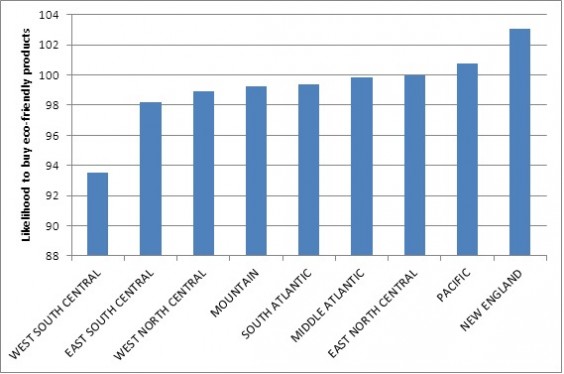
(The regions above are grouped according to census bureau definitions.)
New Englanders are 2.8% more likely than average to buy eco-friendly products. People from the West South Central region – which is Texas, Oklahoma, etc. – were the least likely to buy earth-friendly things, at 6.8% less likely than average. Which reminds me of my favorite quote from this guy on The Simpsons: “In Texas, we got rid of the environment, and everyone was a lot happier.”
Actually, that’s not quite fair. Texas was not on the bottom of the list of eco-friendly states. The bottom five were actually Arizona, Louisiana, Nevada, Oklahoma, and Arkansas. Texas was actually only #40 in eco-friendly purchases – not great, but they are being brought down by their regional neighbors.
And this time around, Vermont wasn’t quite at the top. The top five were actually Alaska, Maine, New Hampshire, Vermont, and Colorado – all outdoorsy-type states, which makes sense. These people care about the environment, probably because their environment is so beautiful.
Generally speaking though, if you want a gift that is good for Mother Earth as well, someone from New England is more likely to get it for you.
7. Generosity is a ten-letter word.
Lastly, perhaps the most surprising thing we found is that there seems to be a correlation between how much someone spends on a gift and how long their last name is.
I’m not exactly sure what to make of this. People with very short last names don’t spend much, whereas people with names 14 letters long spend 16% more than average. Maybe they’re more understanding of others, given how often they’ve had to correct people’s pronunciation of their names. Maybe they’re more compassionate because their names were made fun of as children. I’d love to hear other theories about this. Whatever the reason, the fact remains that, with an r-squared of 0.52, it’s not an insignificant correlation.
(And no, unless Malcolm X and U Thant were UncommonGoods customers, I don’t know who these people are who have one-letter last names. And yes, I know that U is a first name, but I’m having trouble coming up with other examples here.)
How to get a great gift
So, taking all this data together, we can form a picture of an ideal gift-giver: a woman with an AOL email address, 55 or older, who lives in California or New England and has a long, complicated last name. Does this sound like anyone you know? Then you’re in luck.
As for me, let’s see: my mom is definitely older than 55, lives on the California border, and we have a sort of complicated last name. I think she cancelled her AOL account in like 2001, but if I can just find her one of those old signup CD-ROMs, I’ll be all set…
Brian Hashemi is the Marketing Director at UncommonGoods

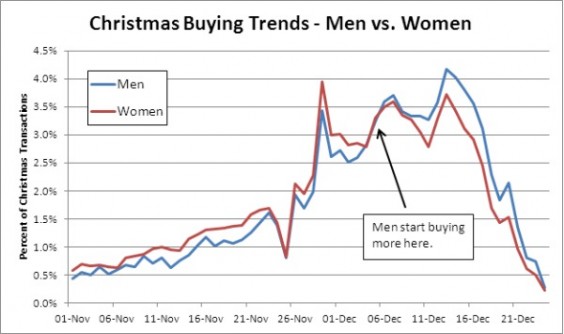
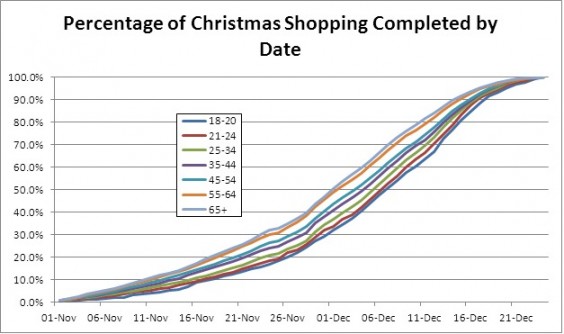
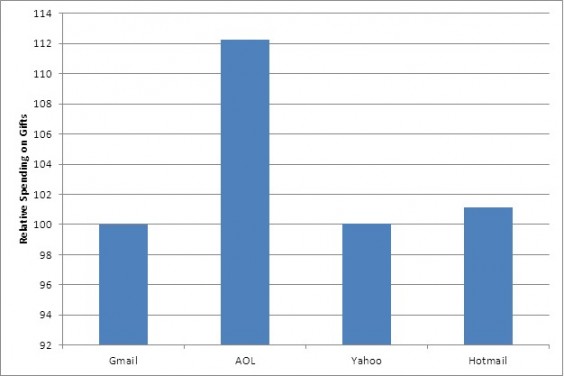
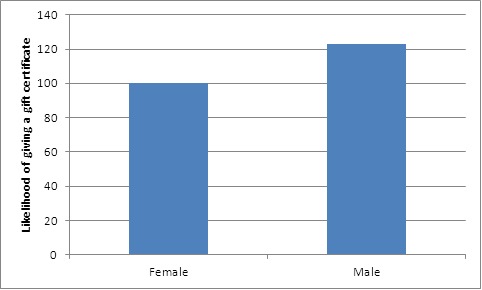
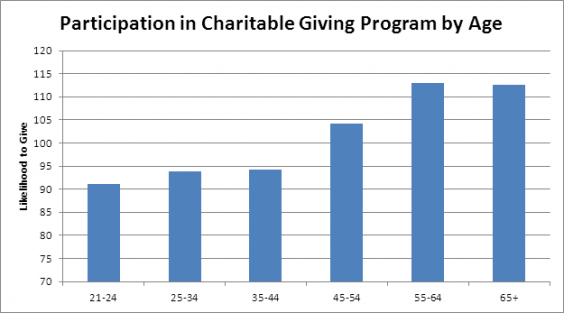
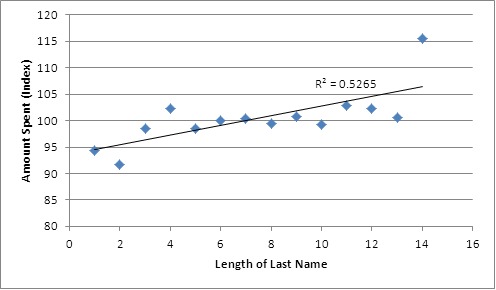
27 Comments
The last finding about the length of your last name and how much you spend is mind blowing! My last name is seven letters long and the amount it correlated to is pretty darn close to what I spent last year and how much I’ll spend this year.
No offense, but the men having a lack of an imagination finding didn’t surprise me. I’ve certainly met some who buck this trend, but the majority do rely on the gift card kiosks at grocery stores for their holiday shopping.
Fascinating stuff, Brian! Thanks!!
Haha, thanks Amy. Maybe this will inspire more men not to buy Christmas gifts at grocery stores!
Brilliant read, Brian! Why this hasn’t been republished on Mashable or ClickZ is beyond me.
Great list! I think the men with giftcards correlates not t a lack of imagination, but to ease and quickness!
[…] and quotes via Uncommon Goods Blog Amazon.com Widgets Share on bebo Share on fark Share on FriendFeed Share on Linkedin […]
[…] going to pay special attention to the number of letters in his last name. Why? According to Uncommon Goods, one of my favorite stores, “People with very short last names don’t spend much, whereas […]
[…] 7 Curious Truths about Christmas Gift Giving […]
First of all, these are interesting data. Thanks for posting them!
About name length to amount spent correlation: seems pretty obvious that there is a cultural latent variable here. My guess is that people of different cultures tend to spend differently on Christmas, and those cultures also correspond to name length. E.g. there are some common short Asian names, Asians tend to be Buddhist, and hence tend to spend less on Christmas, or some other cultural reason, which I won’t venture, so as to avoid broadly stereotyping people. Similarly for long Scandinavian names or hyphenated Spanish names.
Also, your graphs are pretty confusing. Usually when things are normalized, the Y axis has 1 in the center, not 100. Its not clear what your Y axis actually means. Also, when talking statistics, don’t use the term “likelihood” unless you understand what you’re doing. Likelihood has a very technical definition, meaning the probability of the model given the data, in a certain functional form: http://en.wikipedia.org/wiki/Likelihood_function. That’s not what your talking about here. It’s not actually obvious what your graphs mean, exactly.
Thanks for sharing…
@imanon – Glad to see some statistics buffs are reading, I love it! I had to strip out actual dollar values and normalize everything, as you noticed. I normalized to 100 because I felt it looked better in the graphs, especially for a lay audience – but normalizing to 100 or 1 doesn’t change the results. As far as the likelihood is concerned, you’re absolutely right that this does not reflect the statistical definition of a likelihood function – I’m using the term loosely here, again to try to appeal to a lay audience. (Maybe I just made it more confusing in the process.) Anyway, thanks for your feedback!
[…] out all of their findings in the full article here. Uncommon Goods is an online marketplace offering creatively designed, high-quality merchandise at […]
Brian – I can get you one of those AOL CD’s (I’ve kept several from mailings over the years thinking they might come in very handy for a craft project!) I love the stats on New Englanders – I live in NH :-).
@Susan – I love the idea of creating something out of repurposed AOL CDs – sounds like an Uncommon Good to me!
[…] 7 Curious Truths about Christmas Gift Giving […]
I thought it was interesting that the length of your last name correlates with the amount you spend. Your article mentioned it looks like the 65+ age group has 60% of their shopping done by Dec. 4. I am over 60 and my shopping was done by October. I think the reason is that as you get older you don’t like surprises. You want to be able to get what you want when you want. Shopping early also relieves stress. As far as men having no imagination, how true is that.
[…] https://www.uncommongoods.com/blog//2011/7-curious-truths-christmas-gift-giving/ […]
[…] gift ideas that will be both useful and well, uncommon. They also have a blog and have discovered 7 Curious Truths About Christmas Gift Giving. It makes for fun reading. So check out the shop and check out the blog. You will surely enjoy […]
NIce thoughts to buy Christmas gifts
In Christmas time so many gifts are availabe in shops.. People like to buy this gifts and give it to others.
Discover Pins about christmas gift exchange on Pinterest. See more about christmas exchange ideas, christmas games adult and holiday shopping ideas
Discover Pins about christmas gift exchange on Pinterest. See more games about christmas exchange ideas, christmas games adult and holiday shopping ideas
Christmas is a time of gift giving. Tradition say it began once the wise men brought gifts of gold, olibanum and myrrh
Tradition say it began once the wise totnescommunitywindfarm
Each of us carries within ourselves a set of rules about gift-giving. Seldom acknowledged and rarely discussed, these rules determine what we give, how much we give, and to whom we give.
Nice post regarding gift
People like to buy gifts during the Christmas season.
Nice post.
The words in simple way every one should understand easily.